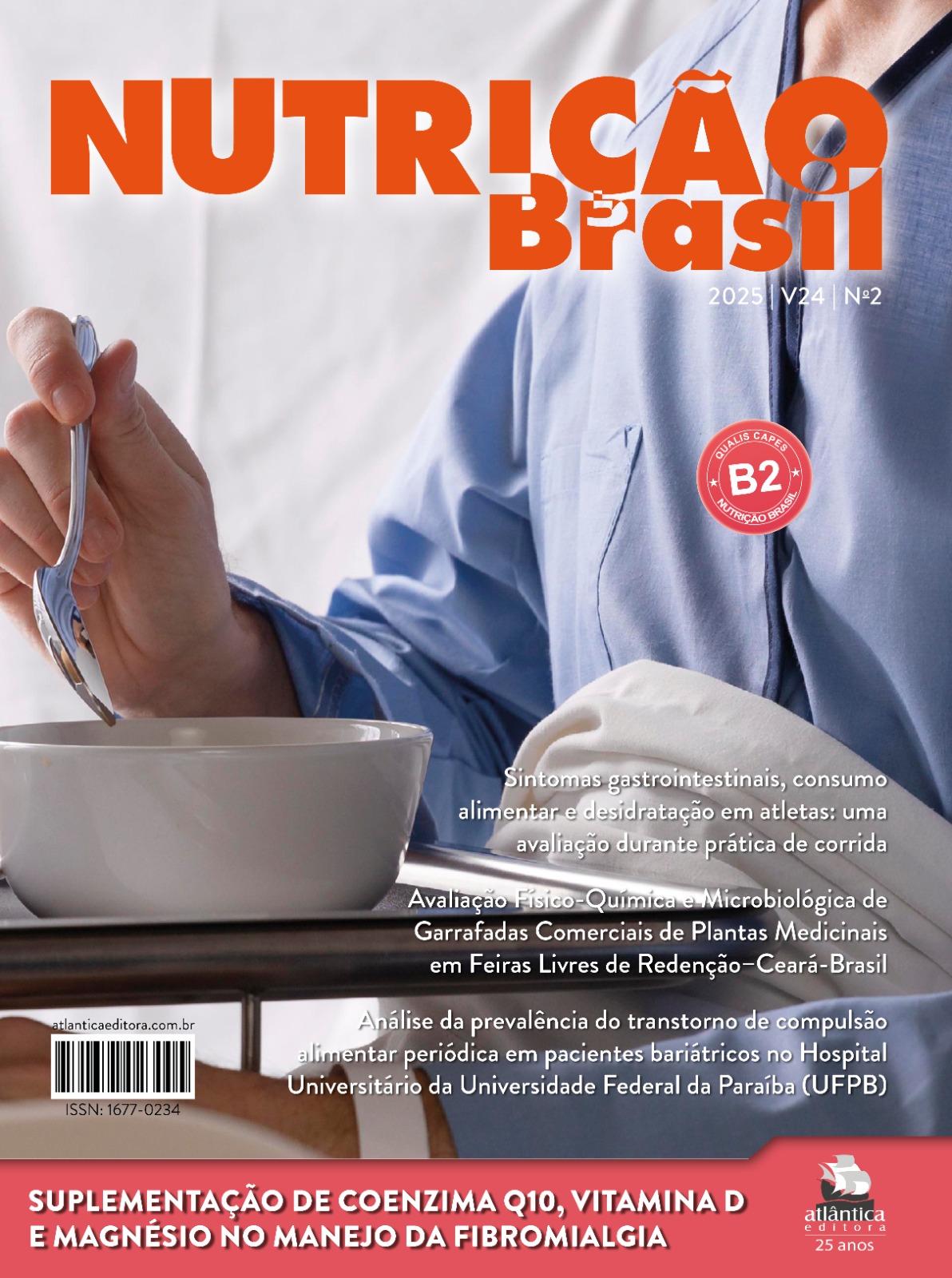Nutritional quality of complementary feeding: comparison between different methods
DOI:
https://doi.org/10.62827/nb.v24i2.3061Keywords:
Feeding behavior; Growth and Development; Child Nutrition.Abstract
Introduction: In the first years of life, infant feeding plays a fundamental role in shaping long-term eating habits. Complementary feeding (CF) should be started at six months of age, providing essential nutrients for the infant's development. Feeding introduction methods vary culturally and include traditional, Baby-Led Weaning (BLW) and participatory. However, the choice of the ideal method is still uncertain. Objective: To identify different ways of introducing complementary feeding to children and how this affects the nutritional quality of the diet. Methods: A cross-sectional study in which 39 women and 40 chidrens were interviewed and provided information on food consumption and the introduction of complementary feeding. The mother-child dyad was part of the research “Evaluation of the cooking skills of puerperal women at a University Hospital” when they were admitted to the Lauro Wanderley University Hospital, between February and May 2021. Contact was made via telephone or WhatsApp, using questionnaires to assess infant feeding. Results: the traditional method favors the consumption of mashed fruit, while the BLW/mixed method encourages greater food exploration, with a prevalence of fruit in pieces. However, the rate of acceptance may be slower in the latter method. Conclusion: the method of food introduction influences the way fruit is consumed, impacting on eating habits.
References
Flores TR, Neves RG, Wendt A, Costa CS, Bertoldi AD, Nunes BP. Padrões de consumo alimentar em crianças menores de dois anos no Brasil: Pesquisa Nacional de Saúde. Ciênc Saúde Colet. 2021;26(2):625–36. doi: 10.1590/141381232021262.13152020
Calixto-Lima L, Gonzalez MC. Nutrição clínica no dia a dia. 2 ed. Rio de Janeiro: Rubio; 2018.
Nogueira-de-Almeida CA, Ribas Filho D, Weffort VRS, Ued FV, Nogueira-de-Almeida CCJ, Nogueira FB, et al. First 2,200 days of life as a window of opportunity for multidisciplinary action regarding the developmental origin of health and disease: positioning of the Brazilian Association of Nutrology. Int J Nutr. 2022;15(3):1-22. doi: 10.54448/ijn22303.
Weffort VRS, Maranhão HS, Mello ED, Barretto JR, Fisberg M, Moretzsohn MA, et al. Guia de orientações: dificuldades alimentares. São Paulo: SBP; 2022.
Temóteo CCS, Fontes DCL, Ferreira AS. Risks and benefits of two different feeding methods. Res Soc Dev [Internet]. 2021 [cited 2025 Apr 5];10(4):e44110414290. doi: 10.33448/rsd-v10i4.14290.
Silva MR. Introdução alimentar tradicional (IAT) x método baby-led weaning (BLW) [Trabalho de Conclusão de Curso]. Goiânia: Universidade Católica de Goiás; 2021.
Białek-Dratwa A, Szczepańska E, Trzop P, Grot M, Grajek M, Kowalski O. Practical implementation of the BLW method during the expansion of the infant diet: a study among Polish children. Front Nutr. 2022;9:890843. doi: 10.3389/fnut.2022.890843.
Rapley G, Forste R, Cameron S, Brown A, Wright C. Baby-led weaning: A new frontier? ICAN. 2015;7(2):77-85. doi: 10.1177/1941406415575931.
Padovani AR. Introdução alimentar participativa [Internet]. 2015 [cited 2023 Sep 26]. Available from: http://tanahoradopapa.com
Brasil. Ministério da Saúde. Sistema de Vigilância Alimentar e Nutricional – SISVAN. Ficha de marcadores de consumo alimentar [Internet]. Brasília: Ministério da Saúde; 2021 [cited 2025 Apr 5]. Available from: https://sisaps.saude.gov.br/sisvan/public/file/ficha_marcadores_alimentar.pdf
Willrich NM. Introdução da alimentação complementar em lactentes de uma cidade da Serra Gaúcha [Trabalho de Conclusão de Curso]. Caxias do Sul: Universidade de Caxias do Sul; 2017.
Brasil. Ministério da Saúde. Guia alimentar para crianças brasileiras menores de 2 anos [Internet]. Brasília: Ministério da Saúde; 2019 [cited 2025 Apr 5]. Available from: https://bvsms.saude.gov.br/bvs/publicacoes/guia_alimentar_crianca_brasileira_versao_resumida.pdf
Dogan E, Yilmaz G, Caylan N, Turgut M, Gokcay G, Oguz MM. Baby-led complementary feeding: randomized controlled study. Pediatr Int. 2018;60(12):1073-80. doi: 10.1111/ped.13671.
Cozzolino SMF. Biodisponibilidade de nutrientes. 6 ed. São Paulo: Manole; 2020.
Cavalari TGF, Sanches RA. Os efeitos da vitamina C. Rev Saúde em Foco [Internet]. 2018 [cited 2025 Feb 18];:749-65. Available from: https://portal.unisepe.com.br/unifia/wp-content/uploads/sites/10001/2018/09/086_Os_efeitos_da_vitamina_C.pdf
Alleo LG, Souza SB, Szarfarc SC. Feeding practices in the first year of life. J Hum Growth Dev [Internet]. 2025 [cited 2025 Feb 18];24(2):195–200. Available from: http://pepsic.bvsalud.org/scielo.php?script=sci_arttext&pid=S0104-12822014000200012&lng=pt&nrm=iso
Silva WC, Gomes TTO, Moreira E. Relação entre o consumo de embutidos de carne e o desenvolvimento de câncer no trato digestório. Rev Ibero-Am Human Ciênc Educ [Internet]. 2022 [cited 2025 Feb 18];8(1):537-45. doi: 10.51891/rease.v8i1.3831.
Lucena N, Silva R, Bezerra M, Oliveira G. Marcadores do consumo de alimentos ultraprocessados em crianças de 06 a 23 meses no Brasil, 2015 a 2018. Rev Ciênc Plur [Internet]. 2022 [cited 2025 Feb 18];8(2):1-18. Available from: https://pesquisa.bvsalud.org/portal/resource/pt/biblio-1368183
Lopes WC, Marques FKS, Oliveira CF, Rodrigues JA, Silveira MF, Caldeira AP, et al. Alimentação de crianças nos primeiros dois anos de vida. Rev Paul Pediatr. 2018;36(2):164-70. doi: 10.1590/1984-0462/2018;36.
Downloads
Published
Issue
Section
License
Copyright (c) 2025 Thamara Rodrigues Melo dos Santos, Maria Francisca de Conceição Maciel Targino, Pietra Maria Pereira de Lima, Bianca Rufino Pimenta, Rogério Mellato Netto , Cinthia Karla Rodrigues do Monte Guedes (Autor)

This work is licensed under a Creative Commons Attribution 4.0 International License.
Autores que publicam nesta revista concordam com os seguintes termos:
Autores mantém os direitos autorais e concedem à revista o direito de primeira publicação, com o trabalho simultaneamente licenciado sob a Licença Creative Commons Attribution 4.0 que permite o compartilhamento do trabalho com reconhecimento da autoria e publicação inicial nesta revista.
Autores têm autorização para distribuição não-exclusiva da versão do trabalho publicada nesta revista (ex.: publicar em repositório institucional ou como capítulo de livro), com reconhecimento de autoria e publicação inicial nesta revista.





